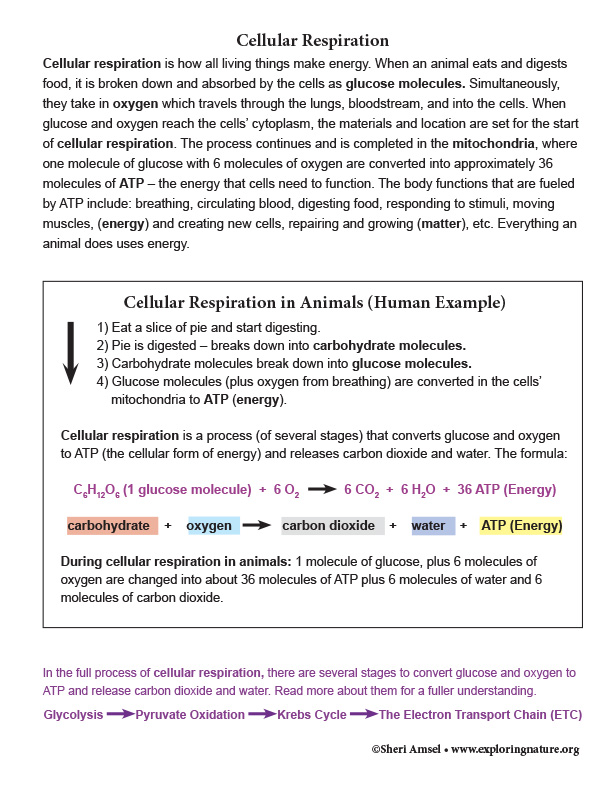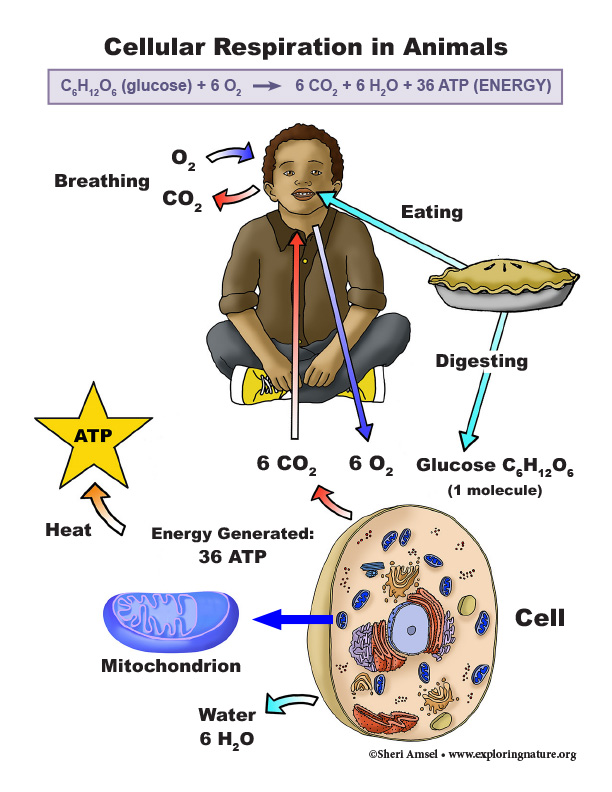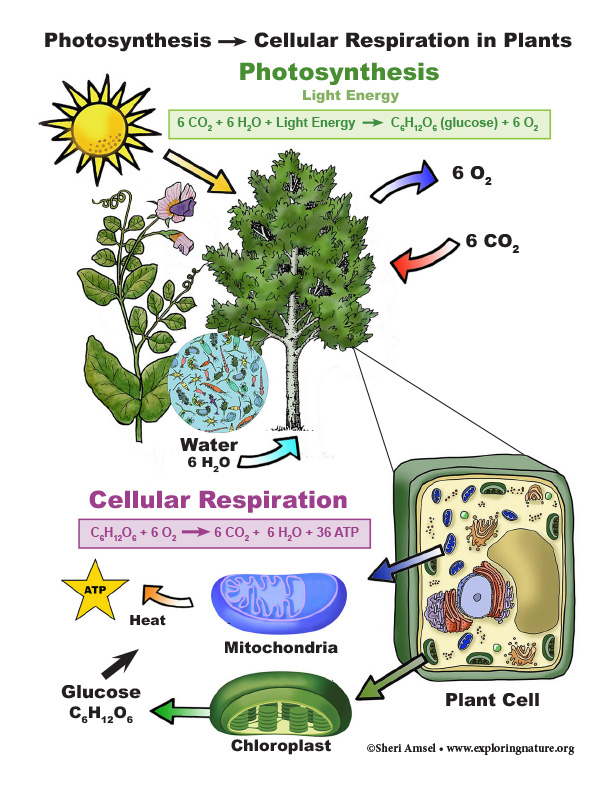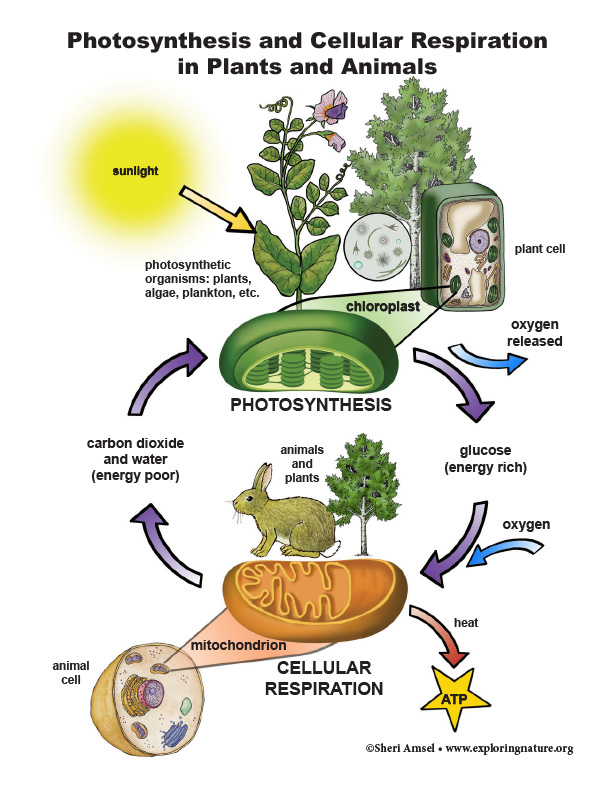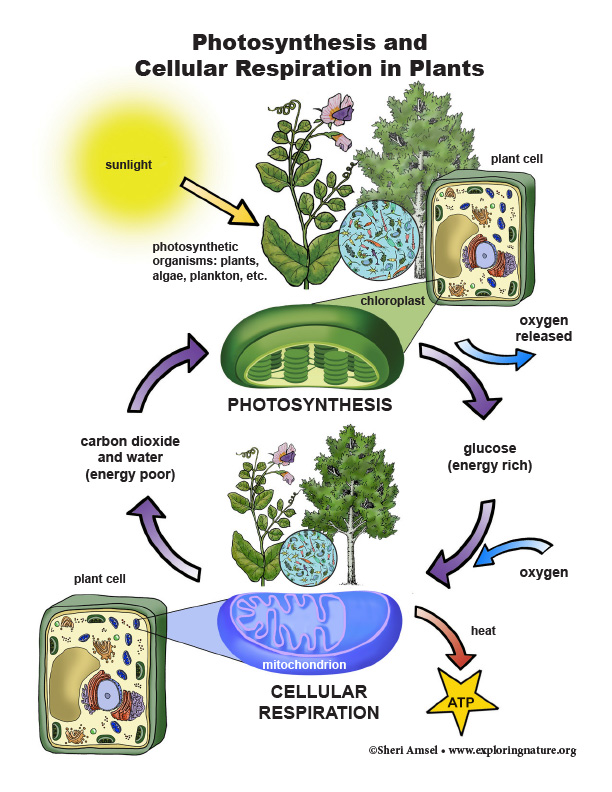

Cellular respiration is how all living things make energy. When an animal eats and digests food, it is broken down and absorbed by the cells as glucose molecules. Simultaneously, they take in oxygen which travels through the lungs, bloodstream, and into the cells. When glucose and oxygen reach the cells’ cytoplasm, the materials and location are set for the start of cellular respiration.
The process continues and is completed in the mitochondria, where one molecule of glucose with 6 molecules of oxygen are converted into approximately 36 molecules of ATP – the energy that cells need to function.
The body functions that are fueled by ATP include: breathing, circulating blood, digesting food, responding to stimuli, moving muscles, (energy) and creating new cells, repairing and growing (matter), etc. Everything an animal does uses energy.
Cellular Respiration in Animals (Human Example):
1) Eat a slice of pie and start digesting.
2) Pie is digested – breaks down into carbohydrate molecules.
3) Carbohydrate molecules break down into glucose molecules.
4) Glucose molecules (plus oxygen from breathing) are converted in the cells’ mitochondria to ATP (energy).
Cellular respiration is a process (of several stages) that converts glucose and oxygen to ATP (the cellular form of energy) and releases carbon dioxide and water. The formula:
C6H12O6 (1 glucose molecule) + 6 O2 ---> 6 CO2 + 6 H2O + 36 ATP (Energy)
carbohydrate + oxygen ---> carbon dioxide + water + ATP (Energy)
During cellular respiration in animals: 1 molecule of glucose, plus 6 molecules of oxygen are changed into about 36 molecules of ATP plus 6 molecules of water and 6 molecules of carbon dioxide.
Put together an 11x17" Poster Version of Cellular Respiration in Animals Plants.
Test your knowledge with Cellular Respiration in Animals - Short Answer Quiz.
Cellular respiration is happening in plants too, but instead of eating to fuel the process, they are using photosynthesis to generate the glucose they need as shown below.
1) Photosynthesis in plants creates glucose molecules (instead of eating).
2) This fuels cellular respiration in the plant cells.
3) Which creates ATP.
4) Which fuels plant growth and reproduction.
This is the formula for Photosynthesis:
6 CO2 + 6 H2O + Light Energy ---> C6H12O6 + 6 O2
carbon dioxide + water + Light Energy ---> glucose + oxygen
This is the formula for Cellular Respiration:
C6H12O6 + 6 O2 ---> 6 CO2 + 6 H2O + 36 ATP (Energy)
glucose + oxygen ---> carbon dioxide + water + ATP (Energy)
Note that plant matter created by photosynthesis will provide the carbohydrates to animals for their cellular respiration and the cycle continues.
Cellular Respiration in Anaerobic Conditions
Cellular respiration needs oxygen to progress. What happens if there is no oxygen present?
In the absence of oxygen, an organism can still create energy through the process of fermentation. Fermentation happens in the cells’ cytoplasm (not in the mitochondria) and generates only 2 ATP molecules per glucose molecule. This is much less effective in generating energy than cellular respiration. Fermentation uses the pyruvate molecules made by glycolysis from glucose. The formula:
C6H12O6 (glucose) ––> CO2 + 2 C2H5OH (alcohol) and some energy
In making of wine and beer (alcohol), yeast cells generate ATP by the fermentation of the sugars in fruit and grain in the absence of oxygen. Yeast can also release carbon dioxide in this process which is what causes bread to rise.
In animals, the lack of oxygen will drive muscle cells to carry on lactate fermentation which creates lactic acid causing sore and cramping muscles. This happens when you get so much exercise that your body runs low on oxygen for cellular respiration.
Disciplinary Core Ideas
LS1.C: Organization for Matter and Energy Flow in Organisms
• The sugar molecules thus formed contain carbon, hydrogen, and oxygen: their hydrocarbon backbones are used to make amino acids and other carbon-based molecules that can be assembled into larger molecules (such as proteins or DNA), used for example to form new cells.
• As matter and energy flow through different organizational levels of living systems, chemical elements are recombined in different ways to form different products.
• As a result of these chemical reactions, energy is transferred from one system of interacting molecules to another. Cellular respiration is a chemical process in which the bonds of food molecules and oxygen molecules are broken and new compounds are formed that can transport energy to muscles. Cellular respiration also releases the energy needed to maintain body temperature despite ongoing energy transfer to the surrounding environment.
Performance Expectations: Students who demonstrate understanding can:
HS-LS1-6. Construct and revise an explanation based on evidence for how carbon, hydrogen, and oxygen from sugar molecules may combine with other elements to form amino acids and/or other large carbon-based molecules. [Clarification Statement: Emphasis is
on using evidence from models and simulations to support explanations.] [Assessment Boundary: Assessment does not include the details of the specific chemical reactions or identification of macromolecules.]
HS-LS1-7. Use a model to illustrate that cellular respiration is a chemical process whereby the bonds of food molecules and oxygen molecules are broken and the bonds in new compounds are formed resulting in a net transfer of energy. [Clarification Statement:
Emphasis is on the conceptual understanding of the inputs and outputs of the process of cellular respiration.] [Assessment Boundary: Assessment should not include identification of the steps or specific processes involved in cellular respiration.]
When you research information you must cite the reference. Citing for websites is different from citing from books, magazines and periodicals. The style of citing shown here is from the MLA Style Citations (Modern Language Association).
When citing a WEBSITE the general format is as follows.
Author Last Name, First Name(s). "Title: Subtitle of Part of Web Page, if appropriate." Title: Subtitle: Section of Page if appropriate. Sponsoring/Publishing Agency, If Given. Additional significant descriptive information. Date of Electronic Publication or other Date, such as Last Updated. Day Month Year of access < URL >.
Amsel, Sheri. "Cellular Respiration in Animals and Plants (Grade 9-12)" Exploring Nature Educational Resource ©2005-2025. May 26, 2025
< http://www.exploringnature.org/db/view/Cellular-Respiration-in-Animals-and-Plants-Grade-9-12 >
